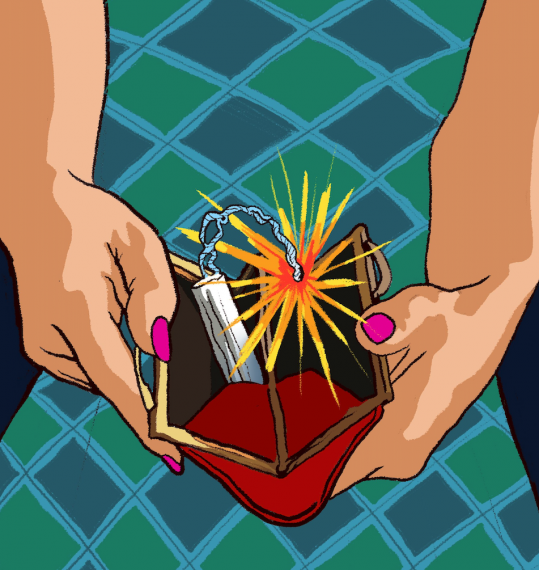How much does menstruation cost?

Period Product Cost Calculator – how do you come up with the idea of creating something like this?
It all started when, together with Julia Żuławińska, we heard the information that in Scotland, sanitary pads and tampons will be available for free in public places. First, we made an English-language calculator, which was addressed mainly to Scottish women and Scots, but also nationals of other countries, to show them how much money women and girls could save.
You say “we made a calculator” as if you were talking about making soup, but it can’t be as simple as that.
At Omni Calculator, where I work, we have the option of creating various types of calculators.
Do you work there while studying medicine?
Only part time.
I still don’t know how students of medicine and biophysics, because your friend Julia studies in this field, can make such a calculator.
Before that, I studied aviation and cosmonautics for a year at the Warsaw University of Technology, I have a fairly good background in mathematics and physics, so creating calculators is very familiar to me and is not difficult for me.
Then you decided to make a Polish version as well?
Yes. We were inspired to do so by the “Różowa skrzyneczka” [“Pink Box”] campaign which helps women affected by period poverty and thanks to which the topic has become a bit more common and discussed in the media. We thought it would be worth shedding some light on it.
We started looking for information on the situation of Polish women and it turned out that there was only one report, the one made by the Kulczyk Foundation. We saw the numbers and realised that the problem in Poland is still really big. By creating the calculator, we wanted to help Polish women plan their home budget, but most of all, we wanted to make people aware of the scale of the phenomenon.
I have friends who think that there is no problem because a pack of sanitary pads costs five zlotys.
Someone who has not come into contact with period poverty themselves, or who does not know a single person affected by this problem, may not be able to realise how real the problem is.
In your calculator you can check how much sanitary products cost us monthly, annually or throughout a person’s lifetime. Have you checked how much you will have to spend?
Yes, and it turned out that I would spend about PLN 6,000 on sanitary pads and tampons during my lifetime.
That’s a lot. At what age did you assume you will no longer menstruate?
At about 45.
Oh, I think you can add a few more years. My friends are giving birth at this age.
Exactly, the amount will be even higher. I would like to point out that we estimate the cost of sanitary products only, and after all, women also buy painkillers, bear the costs of washing underwear, and often clothes and bedding. And finally, there are the costs of productivity at work, which, according to studies, also often decreases. Many women also have to regulate their periods with hormonal drugs, which generates additional costs. There are girls who, due to heavy periods, have anaemia and have to treat it.
You and Julia also wrote an article about period poverty.
Yes, there is a link to it next to our Period Product Cost Calculator. We wrote about the phenomenon and tried to present cheaper and more environmentally-friendly alternatives to traditional pads and tampons, i.e., menstrual cups, reusable pads, and period underwear. Of course, we do not encourage everyone to use them because it is known that these are not substitutes for everyone. To use a menstrual cup, you need to have proper sanitary conditions at school or at work. Some women are also afraid to use one. Fortunately, now there are cup fitters that help adjust the cup so as not to risk a missed purchase. In contrast, reusable sanitary pads require washing, not every woman is able to turn on the washing machine immediately, and they need to be stored somehow after use. Nevertheless, there are more and more solutions, such as reusable tampon applicators, which make life easier for women and can reduce costs and harm to the environment.
Before we make any choices about what to use, we should simply have access to the basic products. And there are still women who have to choose between buying a pack of sanitary pads or three sausages for a child.
For me, it is very important that pads and tampons are available in schools because young girls often have irregular periods and sometimes, they just don’t have any pads with them, and usually they do not have their own money yet. I remember lending each other sanitary pads.
Have you encountered this problem personally?
In high school at least one of the girls did not have pads or tampons regularly. But period poverty was most evident at the beginning of my studies, when hardly anyone worked and earned extra money. You had a budget from your parents and you had to plan your expenses, and it didn’t always work out or was not always enough. “Would you lend me some money for a pack of pads?” we would ask such questions frequently.
And when the calculator appeared, what were the conversations in your circle?
This has greatly fuelled the discussion of period poverty. Many colleagues said they had no idea that it costs so much and that a woman used so many products during a single period. They thought we were talking about several pads over the course of the cycle. I am glad that we were able to contribute to the discussion on period poverty because we still know too little about it in Poland.

